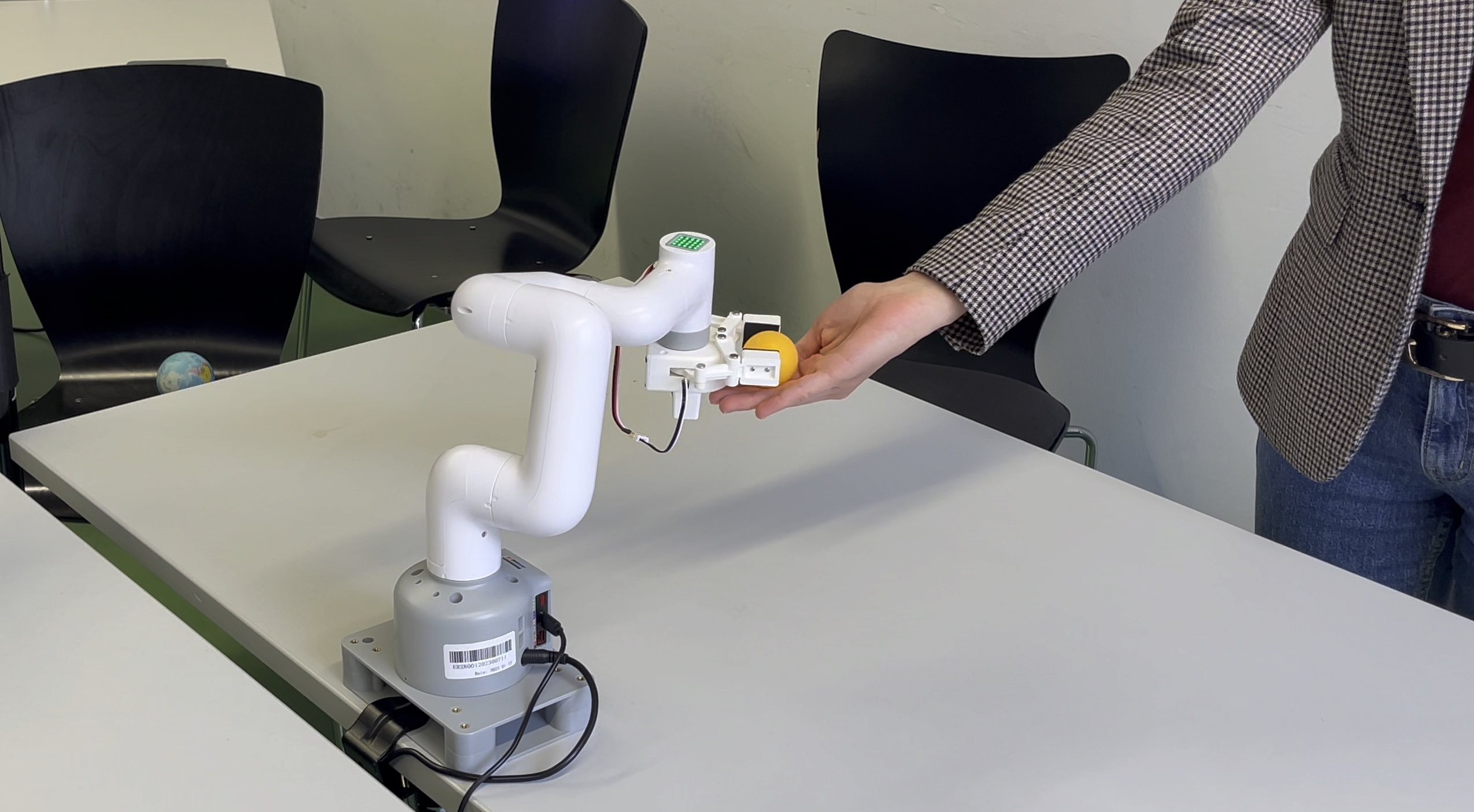This course aims to teach students about current research areas of human-robot interaction (HRI) and the necessary knowledge to implement ideas in that field. After this course, students should have basic knowledge of path and motion planning, inverse kinematics, computer vision approaches for fundamental vision-based actions, and reinforcement learning. With these acquired skills, students should then be able to envision and implement new HRI ideas.
During the semester, students have learned about the abovementioned topics and consolidate the knowledge gained in small exercises. In a week-long session at the end of the semester, they have implemented a novel HRI system in groups of 3-4 people on physical robots and present their findings in a final presentation session. The students have also learned the foundations of ROS during this course. For the projects all teams used an myCobot 280 by Elephant Robotics.
ESRA (Emotional Support Robot Assistant)
Socially assistive robots (SARs) have been found to positively impact reducing loneliness, anxiety, and improving the quality of life of individuals. While most research has focused on the elderly and children, limited attention has been paid to young adults. To fill this gap, we developed the Emotional Support Robot Assistant (ESRA), a robotic companion that provides emotional support to individuals in their daily lives. ESRA focuses on creating a natural interaction experience between the robot and its user, both in terms of input and output. This innovation could significantly impact mental health and emotional well-being in young adults, contributing to the growing body of research on SARs as a tool for emotional support.
by Katharina Danner, Karen Luna Samanez, and Kathrin Schnizer
Bartender Robot
The Bartender Robot is an innovative technology that allows users to create multiple basic drinks, both alcoholic and non-alcoholic, with ease. The robot has a built-in voice recognition system that makes it easy for users to order their drinks, and the system is adjustable to meet individual preferences. We designed the Bartender Robot with a robot arm, gripper, and essential ingredients, which work together to create a seamless and efficient process for making drinks. The robot arm is programmed to mix the ingredients while the gripper picks the ingredients. The basic ingredients are within reach of the arm, making it easy for users to select the desired drink and adjust it to their liking. The Bartender Robot has the potential to revolutionize the way that drinks are made, particularly in settings such as bars and restaurants. The Bartender Robot could reduce wait times and increase customer satisfaction by providing a fast and efficient way to make drinks.
by Tuan Huynh, Vincent Nieraad, Ardian Nuredini
HelpingHand
HelpingHand is an interactive robot designed to assist individuals with everyday tasks in the kitchen and speed up manual processes. Gestures facilitate its simple and intuitive interaction. HelpingHand uses a camera to detect objects and hands, enabling it to assist with stirring, pouring, and slicing tasks. The robot’s design is aimed at helping people with disabilities, the elderly, or anyone who may need assistance with daily kitchen tasks. HelpingHand could help individuals maintain independence and improve their quality of life by providing assistance in the kitchen. Overall, HelpingHand’s innovative design and functionality have the potential to make a significant impact in the lives of individuals who need assistance with daily tasks.
by Hanna Daxer, Laura Gräber, and Ludwig Felder
MEEBO
MEEBO is an interactive robot designed to facilitate hybrid meetings by supporting gesture input and speaker detection. We designed the robot to help users position the camera on the perfect target, whether an object, a speaker, or presentation slides. MEEBO’s gesture input system enables intuitive user control to move the robot easily. The robot’s speaker detection feature helps identify users who speak during a meeting, making it easier to follow the conversation. MEEBO’s innovative design has the potential to revolutionize how we conduct hybrid meetings, making it easier for remote participants to feel engaged and connected to the meeting. By providing support for gesture input and speaker detection, MEEBO could help to improve the overall quality and effectiveness of hybrid meetings.
by Korbinian Hörmann, Karl Benedikt Kaesen, and Phuong Khanh Huynh
The Teaching Team
